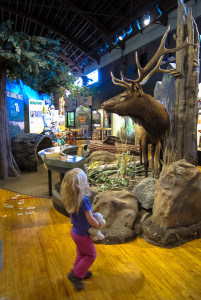Classic Nature
- Blog Classic Nature
Bored one day, my two preschoolers and I visited our county’s historical society museum. The $5 admission fee was a steal for all three of us, and the kids loved looking at all the old tractors, wagons, and washing machines. But they spent most of their time in the newest addition, a beautiful exhibit on the natural history and biology of the area where we live.
 Having worked briefly on visitor center exhibits before, I remembered well the planning, detail, and huge expense that goes into producing such great exhibits. As I watched my kids studying a stream, exclaiming over the fish inside, the irony of it all hit me hard for the first time.
Having worked briefly on visitor center exhibits before, I remembered well the planning, detail, and huge expense that goes into producing such great exhibits. As I watched my kids studying a stream, exclaiming over the fish inside, the irony of it all hit me hard for the first time.
Alana Dimmick is the branch lead for Hike It Baby Eatonville. She is wife to a park ranger, and full time mom to Eli (6), Riley (4), and Isaac (3 months). Alana currently lives in Mount Rainier National Park, Washington.
 Having worked briefly on visitor center exhibits before, I remembered well the planning, detail, and huge expense that goes into producing such great exhibits. As I watched my kids studying a stream, exclaiming over the fish inside, the irony of it all hit me hard for the first time.
Having worked briefly on visitor center exhibits before, I remembered well the planning, detail, and huge expense that goes into producing such great exhibits. As I watched my kids studying a stream, exclaiming over the fish inside, the irony of it all hit me hard for the first time.
We paid money to go inside an air conditioned building with no natural light to gawk over painstakingly created resin and plastic plants and animals, all of which could be found in real life within 25 miles of that building.
We went inside to observe what is outside. We studied lifeless, man-made recreations of the wonders of nature, instead of studying the living, breathing wonders right outside the door. And I suddenly felt the ridiculousness of it all. I was standing under a beautifully sculpted, but decidedly fake, ponderosa tree. Having stood under ponderosas in my own yard, I instantly knew everything that was wrong. There was no sunlight filtering through the branches dappling the ground. No needles under my feet. No air moving. No sound other than other people’s voices. No vanilla extract smell emanating from the trunk. The only sense being stimulated by that experience was sight – and even my sight could immediately identify the ways that tree didn’t measure up to the reality. The better option? Going out to simply stare and wonder at the real thing. Touching the bark of a living ponderosa, instead of a plastic one. Listening for the sound of a real owl, rewarded by our patience, instead of instant gratification at the push of button. Sitting on a stream bank waiting for the sight of a live fish, watching all the water bugs and tadpoles, feeling the cool air and smelling the willows. Discovering things for ourselves, instead of being filled with facts someone else deemed important. A classic in literature is defined as a work that is worth reading over and over, because each time it speaks to you anew. These works are life changing, wisdom bestowing, and inspirational. Well, Nature is also a classic. And the plasticized recreation stuffed into a building will never hold the insights, the experiences, the impact that simply gazing at the same living thing in its habitat will. As my kids ran in and out of a resin hollowed tree trunk, and oohed and aahed over a reproduction beaver lodge, I was deep in thought. Do museums have value then? Certainly. But are we likely to have the connections and inspiration that can come from something truly experienced, instead of just seen? I don’t think so. A picture may be worth a thousand words – even a 3 dimensional one. But so much in this beautiful world can leave you beyond any words at all. And that is a big difference.Alana Dimmick is the branch lead for Hike It Baby Eatonville. She is wife to a park ranger, and full time mom to Eli (6), Riley (4), and Isaac (3 months). Alana currently lives in Mount Rainier National Park, Washington.
Related Content




Comments